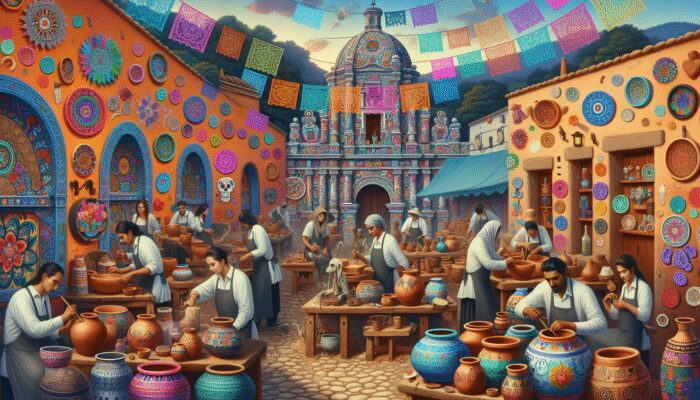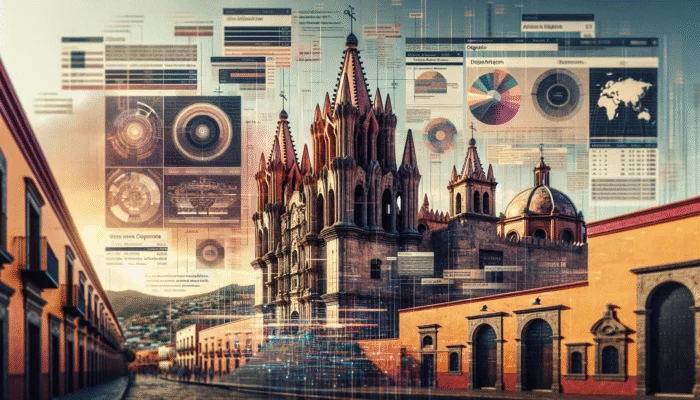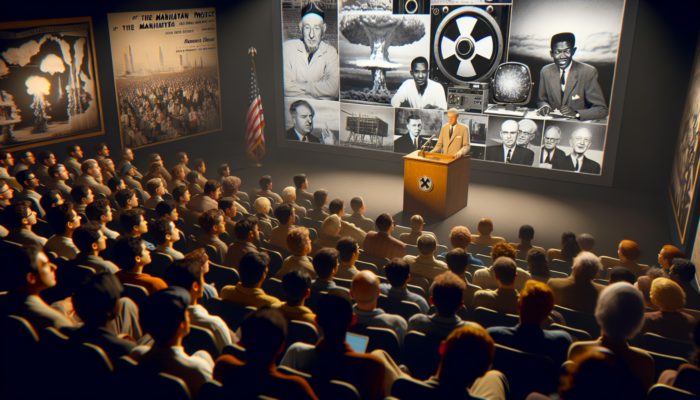El Santuario de Atotonilco, renowned for its stunning artistic achievements, is an essential stop during your exploration of San Miguel de Allende. This extraordinary church is embellished with vibrant frescos and remarkable baroque sculptures, making it a significant pilgrimage destination where thousands gather each year to seek spiritual peace and engage in solemn ceremonies. As a distinguished UNESCO World Heritage Site, its rich historical and cultural importance solidifies its status as a key attraction, captivating visitors from around the world.
Essential Facts and Insights About El Santuario de Atotonilco
- El Santuario de Atotonilco is a prominent UNESCO World Heritage Site, located approximately six miles from the center of San Miguel de Allende.
- The church features intricate frescoes created by Miguel Antonio Martinez de Pocasangre, illustrating powerful narratives of suffering and sacrifice from Christ's life, rendered in a folk Baroque style.
- This revered sanctuary draws around 100,000 visitors yearly, especially during significant penitential services and festivities throughout Holy Week, establishing it as a prominent pilgrimage site.
Discover the Architectural Brilliance of Atotonilco
The Santuario de Atotonilco embodies not just a spiritual haven but also a stunning architectural achievement that captures the creativity and devotion of its era. Built in the 18th century, its modest exterior conceals the elaborate artistry within. The church's design beautifully integrates indigenous motifs with baroque elements, reflecting Mexico's rich cultural legacy and historical narrative, enchanting all who enter its sacred space.
Architectural Design and Structure: A Harmonious Fusion of Traditions
This sanctuary exemplifies a breathtaking blend of stylistic influences, where the lavishness of Baroque artistry harmoniously combines with local craftsmanship. The building is characterized by sturdy adobe walls and a striking bell tower, while its interior is decorated with vibrant frescoes that inspire contemplation and transcend the ordinary. The delicate interplay of light and color creates an almost otherworldly atmosphere, inviting visitors to fully immerse themselves in the sanctity of this captivating space and reflect on its deep spiritual significance.
The Remarkable Artistry of Miguel Antonio Martinez de Pocasangre
At the heart of the Santuario’s mesmerizing interior lies the extraordinary artistry of Miguel Antonio Martinez de Pocasangre. His frescoes, painted in the folk baroque style, are noted for their emotional resonance and vivid storytelling, often depicting the intense and sometimes harrowing episodes in Christ's existence. Each artistic detail contributes significantly to the overarching themes of suffering and redemption that permeate the church, fostering a deep connection with the viewer.
Martinez de Pocasangre’s work represents a unique blend of technique and cultural significance. His vibrant color palette and dramatic figures invite you into a realm where the spiritual and the earthly intertwine. Many of his frescoes illustrate scenes of martyrdom and sacrifice, emphasizing the theme of penitence—a poignant notion for a pilgrimage site. Each brushstroke narrates a story, vividly portraying the intricate relationship between faith and suffering, rendering this sanctuary not just a place of worship but also a dynamic canvas showcasing Mexico's enduring devotion and artistic legacy through the centuries.
Blood and Baroque: The Artistic Journey of El Santuario
El Santuario de Atotonilco presents a stunning array of art that embodies profound themes of suffering, devotion, and redemption. As you traverse its vibrant interior, you become enveloped in the emotional impact of its frescoes, which reflect a visceral connection to the trials faced by Christ and numerous saints. The intricate layering of folk baroque elements provides a sensory spectacle, merging color, form, and deep religious symbolism into an overwhelming artistic experience that resonates with the spirit of the faithful.
Visual Themes of Suffering and Redemption Captured in the Frescoes
Within the sanctuary, various frescoes prominently display scenes of suffering, illustrating Christ’s passion and the tribulations endured by various saints. This emphasis on pain serves as a poignant reminder of the sacrifices integral to the Christian faith. Visitors will encounter striking visuals of bleeding penitents and the tormented expressions of figures, inviting reflection on their own journeys toward redemption through suffering and the transformative power of faith.
The Deep Symbolism Embedded in the Frescoes
The frescoes that adorn El Santuario de Atotonilco are far more than mere decoration; they are imbued with symbolism that engages the observer’s spiritual and emotional senses. Each brushstroke and color choice conveys a narrative steeped in history, faith, and cultural significance. Elements such as the crown of thorns and bleeding wounds emphasize themes of sacrifice, while vibrant flowers symbolize the promise of resurrection and new beginnings.
Within the sanctuary’s intricately detailed frescoes, symbols come alive, vividly expressing the dual themes of suffering and hope. The recurring imagery of Christ’s arduous journey, intertwined with the beauty of nature, creates a compelling contrast. Figures draped in flowing robes often convey both anguish and grace, compelling visitors to delve into the complexities of faith and suffering. Through this artistic narrative, the sanctuary transforms into a canvas for personal reflection, inviting contemplation on the intricate balance of pain and redemption throughout history.
A Sanctuary for Healing: Pilgrimage and Spiritual Rejuvenation
El Santuario de Atotonilco serves as both a spiritual refuge and a destination for individuals in search of healing. Historically, the region has been celebrated for its hot springs, believed to possess restorative properties that enhance overall wellness. This sacred site attracts visitors not only for its breathtaking artistry but also for the promise of spiritual and physical rejuvenation within its hallowed walls, making it a unique destination for those seeking healing.
The Historical Significance of Atotonilco in Mexico’s Narrative
The rich legacy of Atotonilco is intricately interwoven into the historical narrative of Mexico. The church stands as a testament to critical moments in the nation’s quest for independence, including the marriage of Ignacio Allende and the iconic events led by Padre Hidalgo, who rallied his followers within these very walls. It symbolizes the intertwining of faith and freedom, evolving into a rallying point for individuals seeking both spiritual solace and national identity during tumultuous periods in history.
Modern Pilgrims: Engaging in Rituals and Spiritual Practices
In contemporary times, pilgrims actively participate in various rituals to express their devotion. Many visitors engage in traditional acts of penance, such as walking on their knees around the church or practicing self-flagellation as a reflection of Christ’s suffering. These practices underscore a profound commitment to spiritual purification, making each pilgrimage a deeply personal journey. Additionally, special services and events punctuate the church’s calendar, drawing thousands who seek renewal within its sacred environment and collective community.
The actions of modern pilgrims represent a blend of physical endurance and spiritual purpose. Some individuals willingly embrace discomfort, adhering to the belief that suffering serves as a pathway to deeper faith. Utilizing items like nopal cactus bundles and hair shirts exemplifies their devotion, while communal services foster a sense of shared experience among the faithful. The pilgrimage transforms into not only a physical journey but also a transformative process, encouraging profound reflection and renewal, allowing individuals to connect intimately with both the historical and spiritual significance of El Santuario de Atotonilco.
Reviving Reverence: Restoration Initiatives Breathing New Life into Atotonilco
Restoration initiatives for El Santuario de Atotonilco have revitalized the site, transforming it from a neglected structure into a vibrant symbol of cultural pride. Years of exposure to moisture, dust, and neglect threatened the church’s magnificence, leading to its inclusion on the World Monuments Fund’s endangered sites list in 1996. The collaborative restoration project, led by dedicated heritage organizations and local stakeholders, has rejuvenated the remarkable artistry that defines the sanctuary, ensuring its preservation for future generations.
The Challenges of Neglect: Safeguarding a UNESCO World Heritage Site
Being designated as a UNESCO World Heritage Site in 2008 highlighted the urgent need for prompt intervention to protect El Santuario de Atotonilco from further decline. Without timely restoration efforts, the extraordinary artwork and architectural integrity of the church faced significant threats. The combination of natural elements and human neglect posed a risk of erasing centuries of rich history inscribed on its walls, necessitating immediate action to preserve this vital cultural landmark.
International Support: A Cornerstone for Successful Restoration Efforts
International support has been crucial in driving the restoration of El Santuario de Atotonilco, providing essential funding and expertise necessary for the project. Contributions from organizations such as the World Monuments Fund and American Express have supplied critical resources for the renovation process. Their financial backing, combined with local investments, has empowered skilled conservationists to conduct thorough assessments and implement sensitive restoration strategies that respect the church’s artistic heritage while ensuring its longevity.
The restoration initiative, launched with the support of international entities, focused on meticulously analyzing the original materials and techniques that defined the 18th-century construction of the sanctuary. Under the expert guidance of conservation teams, careful cleaning and restoration of murals and frescos were conducted, ensuring that the intricate details and vibrant colors are returned to their original splendor. This approach not only preserved the site’s historical significance but also fostered a sense of community identity and pride among locals and visitors alike.
The Cultural and Political Landscape of Atotonilco: A Rich Historical Tapestry
Atotonilco is not merely a spiritual center; its rich cultural and political history intertwines with the broader narrative of Mexico. This village exemplifies the convergence of indigenous beliefs and colonial influences, reflected in its traditions, art, and the importance of the Santuario. Here, history and culture amalgamate to forge a unique identity that embodies the resilience and faith of the local people, establishing it as a significant point of interest.
The Influence of Atotonilco on Mexican Independence
The Santuario de Atotonilco played a pivotal role in Mexico’s struggle for independence. On September 16, 1810, Padre Miguel Hidalgo rallied his followers in this sacred space, seizing the renowned banner of the Virgin of Guadalupe. This act of reverence transformed the church into a powerful symbol of freedom, motivating countless Mexicans to join the fight against colonial oppression and injustice, marking a watershed moment in the nation's history.
Cultural Celebrations: The Contemporary Importance of Rituals
Today, the Santuario hosts vibrant celebrations, especially during Holy Week, reinforcing both faith and community ties. Thousands partake in ritual processions and acts of penance, honoring traditions that have withstood the test of time. These rituals serve not only as expressions of devotion but also as unifying events for the local and broader Mexican community, highlighting the enduring relevance of this sacred site.
These contemporary festivities create a rich tapestry of sights, sounds, and emotions that link the past with the present. Rituals such as the torchlit procession featuring the Our Lord of the Column underscore the lasting significance of the church as a focal point for shared identity and heritage. Each year, approximately 100,000 pilgrims flock to Atotonilco, embodying a spirit of unity and unwavering faith. As you participate in these celebrations, you’ll find yourself woven into the fabric of a living tradition that honors both the sacred and the historical legacy of this remarkable site.
Embark on Your Journey to El Santuario de Atotonilco: An Unforgettable Experience Awaits
Your visit to El Santuario de Atotonilco, often referred to as the Sistine Chapel of the Americas, offers an unparalleled insight into Mexico’s rich cultural and religious heritage. This UNESCO World Heritage Site invites you to explore its stunning baroque art and experience the profound atmosphere of pilgrimage and devotion. Whether you admire the intricate frescoes or engage in revered traditions, Atotonilco guarantees a memorable journey into the heart of spirituality and history, conveniently located just a short drive from San Miguel de Allende.
Common Inquiries about El Santuario de Atotonilco
Q: What is the significance of El Santuario de Atotonilco?
A: El Santuario de Atotonilco is celebrated for its breathtaking Baroque art and is often referred to as the “Sistine Chapel of the Americas.” The interior features intricate frescoes, sculptures, and detailed murals depicting various scenes from the life of Christ, frequently focusing on themes of suffering and penitence, establishing it as a crucial spiritual landmark.
Q: Why do so many pilgrims visit El Santuario de Atotonilco?
A: El Santuario de Atotonilco serves as a vital pilgrimage site for many Mexicans, especially during special penitential services. Pilgrims often engage in acts of devotion, such as walking on their knees or using flagellant whips, as a reflection of their faith. The church accommodates approximately 100,000 visitors annually, providing dormitories and dining facilities for those seeking spiritual guidance.
Q: What is the best way for visitors to reach El Santuario de Atotonilco from San Miguel de Allende?
A: Visitors can easily reach El Santuario de Atotonilco by taking the Carretera a Dolores Hidalgo road. It is approximately a ten-minute drive from San Miguel de Allende. Travellers should stay left and take the “Desviacion a Atotonilco” turnoff to arrive at the sanctuary, ensuring a smooth journey to this remarkable site.
The Article: El Santuario de Atotonilco: The Sistine Chapel of the Americas appeared first on https://fallinginlovewithsanmiguel.com/
The Article Atotonilco: The Americas’ Sistine Chapel Experience Was Found On https://limitsofstrategy.com
The Article Atotonilco: Experience the Sistine Chapel of the Americas First Appeared ON
: https://ad4sc.com













Leave a Reply